Presidents
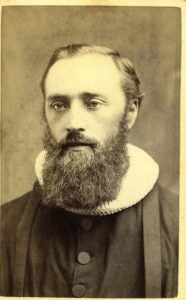
Laur Larsen
First President of Luther College (1861-1902).
Early Years
Peter Lauritz (Laur.) Larsen, the first president of Luther College, was born August 10, 1833 in Kristiansand, Norway. He was the oldest of nine children. One of his teachers, Christian Thistedahl, had a major influence on Larsen’s spirituality. Larsen said of him, “The one thing for which I owe Thistedahl the greatest thanks is that he made me a conscious Christian during the first year that he was my teacher. Very soon I reached the decision that I would become a pastor” (quoted in Kolsrud Thistedahl 245. cited in Karen Larsen Laur. Larsen 15).
After growing up in Kristiansand, a town of about eight hundred residents during Larsen’s childhood, Larsen moved to Kristiania in 1850 and began attending the university there at the age of seventeen. After earning his bachelor’s degree, he was a theological student from early 1852 to June 1855. Larsen worked as a part-time tutor throughout most of his university years, and he continued to teach after he completed his courses.
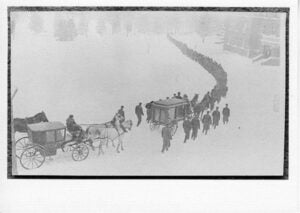
Larsen funeral procession
Larsen and Karen Randine Neuberg were married in Bergen, Norway, on July 23, 1855. Their families were distantly related through cousins and had known each other for several years. The Larsen’s first child, Thora, was born on July 16, 1857.
There was a surplus of pastors in Norway during that time period, and Larsen was in the midst of trying to find a job when he learned of six pastoral calls in America. He decided to leave Norway and emigrate to America, where he knew that he would be able to address the needs of other Norwegian Lutherans. After he was ordained in Our Savior’s Church in Kristiania on September 23, 1857, he and his family left for Fillmore County, Minnesota, where Larsen had accepted a call.
On their way to Fillmore County, the Larsens visited the parsonage of Adolph C. Preus, who was at that time the president of the Norwegian Evangelical Lutheran Church of America (NELC). Larsen felt comfortable with the Norwegian Synod, and he later said that he believed the Synod to be “the true daughter of the mother church at home” (quoted in “Atter nogle gamle minder” in Symra 9:244-246 (1913). cited in Larsen 37).
The Road to Luther
On October 10, 1857, the Norwegian Synod decided to establish an institution of higher learning with a Norwegian background in America. They first used Concordia Seminary in St. Louis (which was, in turn, a part of the Missouri Synod) in order to have a professorship there until there was enough money to start a college. The church council that made this decision met at Washington Prairie church. (David T. Nelson 33)
Laur. Larsen started his position as professor at Concordia Seminary on October 14, 1859. This day is now recognized as Founder’s Day for Luther College. (Nelson 38-39)
When the Civil War began in April 1861, Concordia Seminary was closed, the NELC decided to open its own college that fall in a former parsonage at Halfway Creek, Wisconsin, just north of La Crosse, Wisconsin and close to present day Holmen, Wisconsin. On September 1, 1861, classes for Luther College officially began with an enrollment of 16. The college was initially focused on training young Norwegian-American men to become members of the clergy.
The following year classes moved to Decorah, Iowa, with NELC Pastor Ulrik Vilhelm Koren successfully arranging the college’s relocation and permanent settlement. On September 2, 1862, the first classes were held in Decorah. Luther College was dedicated on October 14, 1865, and the day owed itself in substantial part to the efforts of Larsen.
Years at Luther
Larsen was placed at the head of Luther College. While he worked as one of the two professors, Larsen taught seventeen of the forty-four class hours. He was also in charge “of all general affairs of the institution, including the purchase of supplies” (Larsen, Karen. Laur. Larsen 142). When necessary, he also acted as nurse for his students.
On February 6, 1871, Larsen’s wife Karen died. She had been a major presence in his life, and their relationship had been a strong, loving, and vibrant one.
Larsen continued to teach and to serve on committees for the Synod and the college. He also wrote several editorials and papers that were intended to help share the views and beliefs of the institutions.
There are countless stories and recollections of students who remembered Larsen’s acts of dedication and kindness to them. Some of them even continued to keep a correspondence with him after they graduated.
While visiting in Kristiania during the summer of 1872, Larsen met Ingeborg Astrup. They quickly became engaged, and they were married on August 20, 1872. Larsen’s final visit to Norway was in 1882, when he returned to his native country for his parents’ golden anniversary celebrations.
In the early days of the college, the majority of its classes used Norwegian to communicate. Over time, Larsen began to advocate the increased use of English. Norwegian was to still be used as a mother tongue, but he believed that an effort towards bilingual abilities must be attempted. Larsen also worked hard to “lengthen the course from six to seven years and to separate the preparatory and collegiate departments” (Larsen 251).
The fire of Main May 19, 1889 came as a shock to Larsen, the faculty, the students, the Synod, and the citizens of Decorah. The primary building – where classes, meals, offices, and sleeping quarters were housed – was destroyed. After a debate within the committee about what the next steps should be, the decision was made to rebuild the college in Decorah, which pleased Larsen. The new Main building was dedicated on October 14, 1890.
After forty-one years as the president of Luther College, Larsen stepped down on July 31, 1902. He was replaced by C. K. Preus. Larsen continued to teach Hebrew for nine more years before retiring from his professor duties in 1911. He had been a teacher for sixty years.
After Luther
Larsen continued to be a voice in the Synod and in the Norwegian-American community. A significant amount of his energy was spent reading, writing, and speaking in ways that would help Luther College and the Synod. He worked as the editor of Kirketidende for a few additional years after he retired from the presidency. Larsen retired from Kirketidende in the summer of 1912, following his second minor stroke.
Larsen died peacefully in his sleep on March 1, 1915. Ingeborg died on November 19, 1923 in her sleep.
Other Information
The first separate dormitory building was built a few years after Larsen retired from the presidency. Laur. Larsen Hall, as it was named, opened in 1907.
The King of Norway bestowed on Larsen the Order of St. Olaf in 1908.
Larsen’s dedication to Luther College was immense and thorough. He spent long hours in his office taking care of college necessities, and his mission to lead the college through its early days often eclipsed his personal needs and wishes.
Resources in the Luther College Archives
- Laur. Larsen — collected materials
- Laur. Larsen, Luther College President by Karen Larsen
Works Referenced
- Larsen, Karen, Laur. Larsen, Luther College President, Norwegian-American Historical Association, Northfield: 1936.
- Nelson, David T., Luther College 1861-1961, Luther College Press, Decorah: 1961.
External Resources
Luther College Archives
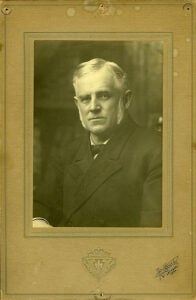
C. K. Preus
Second President of Luther College (1902-1921)
Early Years
Christian Keyser (C. K.) Preus, the second president of Luther College, was born on October 13, 1852 in the Spring Prairie parsonage of Wisconsin to Herman Amberg Preus and Caroline (Linka) Keyser Preus. He had connections with the Norwegian Synod from childhood through his father’s involvement with the church.
Preus entered Luther College as a student in 1865, but typhoid fever forced him to temporarily withdraw. He resumed his studies in 1868 and graduated from Luther College in 1873. He had been on Luther’s first baseball team in 1872.
He later graduated from Concordia Seminary in 1876. He was ordained that year and soon went to Spring Prairie, Wisconsin, to help his father at his congregation. He split his time between Spring Prairie and Our Saviour’s Church in Chicago during the span of time between 1893-1895. Even after his father passed away in 1894, Preus continued to work at the Spring Prairie parish until 1897, when his own health faltered.
Preus married Louise Augusta Hjort in 1877. Her father was Ove Jakob Hjort, a pioneer pastor like Preus’s own father.
Years at Luther
Preus moved to Decorah in the summer of 1897 and moved into “Sunnyside” house. In 1898 Preus accepted a teaching job in the preparatory department at Luther College, where he was an instructor in both religion and Norwegian.
Even after assuming the presidency of Luther in 1902, he continued to teach Latin, Norwegian, and religion. The changes to the curriculum and campus under Preus were momentous. In 1915, the college was accredited by the North Central Association of Colleges and Secondary Schools, and tuition was charged for the first time: twenty dollars per semester for the college department. Hebrew was dropped as a required course in 1919 and the curriculum revised to allow more electives and “majors.” The physical campus also changed. The gymnasium tripled in size with the addition of an auditorium in 1903. Larsen Hall was built in 1907 providing dormitory, office, and classroom space. In 1909-1910, Jens Jensen, a prominent landscape architect, suggested new landscape designs for the campus and in 1921 the cornerstone was laid for the Koren Hall Library and Museum.
During the Preus presidency Luther also celebrated its 50th anniversary, survived World War I, participated in the 1915 Panama-Pacific International Exposition, sent its Concert Band to Europe in 1914, and expanded the faculty and student enrollment. While overseeing many administrative aspects of the college, Preus was also active in the Norwegian Synod which later evolved into the Norwegian Church in America.
During Preus’s presidency, the relationship between Luther College and the Norwegian Synod shifted. In 1917, the uniting of the various synods to form the Norwegian Lutheran Evangelical Lutheran Church of America meant that was no longer the main school supported by the church. Now it “became one of two colleges (the other being St. Olaf) to which the church was fully committed; and it was not many years before it found it was one of four, eventually five colleges, which laid claim to the church’s support” (Nelson 169-170). Luther soon learned that the attention and funds were moving towards the other few sponsored schools rather than just themselves. The need to become more self-sufficient was evident.
Preus was a leader in other respects as well. He was a charter member and the first Iowa District president of the Choral Union of the Synod, which was organized in 1903. In addition, he was was vice-president of the Norwegian Synod since 1911, vice-president of the Iowa District of the Norwegian Lutheran Church of America since 1917, president of the Winneshiek County Old Settlers’ Association in 1913, and the first president of the Educational Association of the Norwegian Lutheran Church of America. (Christian Keyser Preus 142-143)
C. K. Preus died on May 28, 1921.
Resources in the Luther College Archives
- Preus Family — collected materials
- Luther College 1861-1961 by David T. Nelson
- Christian Keyser Preus by various contributors
Works Referenced
- Who’s Who in the Luther College Archives
- Nelson, David T., Luther College 1861-1961, Luther College Press, Decorah: 1961.
External Sources
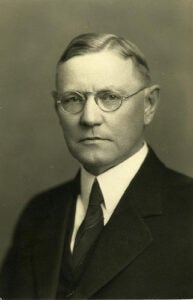
Oscar Olson
Third President of Luther College
Early Years
Oscar Ludvig (Oscar L.) Olson, the third president of Luther College, was born on February 3, 1872 in Chicago, Illinois to Andrew B. Olson and Guroe Larsen Krogstad. After moving to Sycamore, Illinois, in 1874 and Dixon, Illinois, in 1875, the family moved to Marcus, Iowa, in 1879, where they settled in for many years. His mother died of typhoid fever in 1885. Olson’s father, who was a blacksmith by trade, asked the boy if he would like to attend Luther College. Olson was fourteen years old when he entered Luther College on September 2, 1886.
Years at Luther
Valedictorian at Luther in 1893, Olson went on to complete an M.A. at the University of Minnesota and a Ph.D. in English at the University of Chicago in 1914. Olson returned to Luther in 1901 to teach English. The first layman to become president of a major Lutheran college, Oscar L. Olson was chosen to fill the position left by the death of C. K. Preus in 1921. During his presidency (1921-1932), expansion of the grounds continued the process begun by his predecessor. 1926 saw the addition of the C.K. Preus Gymnasium to the campus and acquisition of the Frank Jewell farm on the edge of the college. Nustad Field was dedicated in 1931. Hardships also came with the presidency as Olson had to cope with the stock market crash in 1929 and the Great Depression that followed. Enrollment began to fall because of the Depression and the college fell into serious debt as the endowment failed to keep pace with expenses. Olson advocated a change away from the classics curriculum to one of liberal arts and the admission of women to attract more students and funds to Luther. The curriculum change was approved, but not the admission of women. In 1932, with a college debt of $218,000, Olson was asked to resign. He continued to teach English at the college until retiring in 1952. His fifty-one year teaching career at Luther is both a record and a testament of his loyalty to the college.
After Luther
In 1955, the new men’s dormitory was named in his honor. Olson passed away on November 19, 1956.
Other Information
Olson married Clara Gullixson of Bode, Iowa. They had two sons.
During Homecoming on October 12, 1951, he was given an honorary Doctor of Letters.
Resources in the Luther College Archives
- Luther College 1861-1961 by David T. Nelson
Works Referenced
- Nelson, David T., Luther College 1861-1961, Luther College Press, Decorah: 1961.
- Who’s Who in the Luther College Archives
External Resources
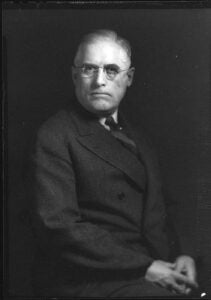
Ove J. H. Preus
Fourth President of Luther College
Early Years
Ove Jacob Hjort (J. H.) Preus, the fourth president of Luther College, was born on January 21, 1880 in Spring Prairie, Wisconsin to C. K. Preus, the second president of Luther College, and Louise Augusta Hjort. Both of his parents were members of well-known Norwegian-American families. He began to attend Luther College in 1895.
Years at Luther
Ove Jacob Hjort Preus (1880-1951) A 1901 Luther graduate, Preus earned degrees in theology and law. He also “completed the course at Luther Seminary in 1904, and spent a year in postgraduate study at Johns Hopkins University in 1904-05” (Nelson 251). He served as a pastor in Washington and Wisconsin from 1905 to 1929. He served as president of two colleges, Augustana College in South Dakota and Luther College in Decorah, Iowa, serving as Luther’s fourth president from 1932 to 1948. His term at Luther spanned a crucial period in the college’s history, which included declining enrollments, financial difficulties, the possible loss of accreditation and rumors of mergers with other colleges. Highlights of his term of office included the institution of co-education, the Diamond Jubilee, the burning of Main, and major changes in the governance of the college. After weathering the Great Depression and facing World War II, he retired from the presidency on June 30, 1948. He taught part-time at Luther until his death on February 13, 1951.
Other Information
Preus married Amanda Magdalene Forde in 1908. She was the daughter of Nils Førde and his wife Nora Otilia (Erickson) Førde. They had six children.
Resources in the Luther College Archives
- Luther College 1861-1961 by David T. Nelson
Works Referenced
- Nelson, David T., Luther College 1861-1961, Luther College Press, Decorah: 1961.
- Who’s Who in the Luther College Archives
External Resources
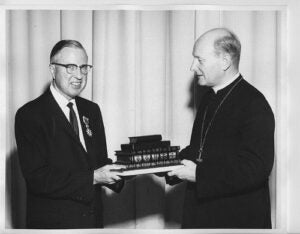
J. Wilhelm Ylvisaker
Fifth President of Luther College (1948-1962)
Early Years
Johannes Wilhelm (J. Wilhelm) Ylvisaker, the fifth president of Luther College, was born on April 18, 1900 in Robbinsdale, Minnesota, to Johannes Th. Ylvisaker. He attended Luther College and graduated in 1921. He studied three years at Luther Theological Seminary, completing an M.Th. at Princeton Theological Seminary in 1926. In 1930, he married Lucille Torgerson of McFarland, Wisconsin. They had two children. He served as the pastor of Northwood, Iowa, and of Our Saviour’s Lutheran Church in Minneapolis, Minnesota, which made him “one of 14 members of the two branches of the Ylvisaker family to serve as pastors and missionaries in the Lutheran Church in this country” (Nelson 303).
Years at Luther
J.W. Ylvisaker (1900-1981) Ylvisaker became president of Luther College on June 10, 1948. Ylvisaker’s presidency from 1948 to 1962 was marked by growth and development in almost every aspect of the college. Six major buildings were completed, attendance skyrocketed, the endowment grew, and a development plan was created and implemented for the first time. While many changes took place over his fourteen years in office, Ylvisaker tried to work within the traditions of the school to maintain the stability established by his predecessor, Ove J. H. Preus. In addition to being president of the college, he was also “president of the Association of Iowa College Presidents, of the Iowa College Foundation 1953-55, and of the National Lutheran Educational Conference in 1959” (Nelson 304). His patience, intelligence, and wit were assets to his office and college. J.W. Ylvisaker resigned in 1962 after developing Parkinson’s Disease and passed away in 1981.
Resources in the Luther College Archives
- Luther College 1861-1961 by David T. Nelson
Works Referenced
- Nelson, David T., Luther College 1861-1961, Luther College Press, Decorah: 1961.
- Who’s Who in the Luther College Archives
External Resources
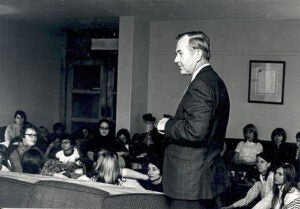
Elwin D. Farwell
Sixth President of Luther College (1963-1981)
Early Years
Elwin D. Farwell, the sixth president of Luther College, was born on May 1, 1919 in Branch County, Michigan. He married Helen Irene Hill in August 1942. They have four children. A 1943 graduate of Michigan State University with a degree in animal husbandry, he received a B.D. degree from Pacific Lutheran Theological Seminary in 1959 and held the position of academic dean at California Lutheran College before his call to Luther.
Years at Luther
The second century of Luther College was ushered in by its sixth president, Elwin D. Farwell, who was officially inaugurated on May 11, 1963.. Described by Leigh Jordahl and Harris Kaasa in their college history as the most assertive of Luther’s presidents, Farwell’s presidency (1963-1981) was called “democracy with a strong executive branch.” During the Farwell years the faculty expanded and diversified away from a homogeneous mixture of Lutherans, Luther graduates, and Scandinavians. Enrollment increased and the building program started under J. W. Ylvisaker continued as Ylvisaker Hall, Miller and Dieseth Halls, the Center for Faith and Life, and Preus Library were completed. A strong commitment to a liberal arts curriculum was made by Farwell as the calendar was changed to a 4-1-4 system, along with the addition of the Freshman Core Program in 1964 and later Paideia in 1977. Disturbances, such as the early closing of school due to race relations in December of 1971 or the student occupation of Main in 1973, were handled coolly and competently by Farwell. His retirement in 1981 marked the end of an era for Luther College, one that saw much change but still retained the strong academic and social characteristics the school has always maintained.
Resources in the Luther College Archives
- Stability and Change: Luther College in Its Second Century by Leigh D. Jordahl and Harris E. Kaasa
Works Referenced
- Jordahl, Leigh D. and Harris E. Kaasa, Stability and Change: Luther College in Its Second Century, Luther College Press, Decorah: 1986.
- Who’s Who in the Luther College Archives
External Resources
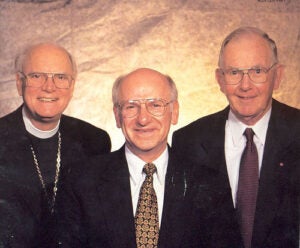
H. George Anderson (left), Jeffery Baker (center), E. D. Farwell (right)
Seventh President of Luther College (1982-1995)
Early Years
Hugh George (H. George) Anderson, the seventh president of Luther College, was born on March 10, 1932 in Los Angeles, California. After receiving a B.A. from Yale University and attending the Lutheran Theological Seminary at Philadelphia, he eventually became president of the Lutheran Theological Southern Seminary in 1970. In 1956, he married Synnove (Sunny) Hella, who originally came from Bergen, Norway. They had two children.
Years at Luther
Anderson is known for being a quiet man with a matter of fact style. The Andersons arrived in Decorah on New Years Eve 1981 and President Anderson began work on January 2nd, 1982. His inauguration was planned for March 26-28 and despite his wife’s poor health, the celebration went on as planned. A week after the inauguration Sunny Anderson died after a long battle with cancer. In 1983, he married the former Jutta Fischer Herrmann, who had two young sons.
One of the major challenges Anderson faced during his years at Luther was a decline in the number of high school graduates from the areas where Luther usually drew its students. In response, Anderson worked to overcome the demographic projections by attempting to maintain a stable enrollment of around 2000 students. One of the strategies he employed to accomplish this goal was to enhance Luther’s visibility. He also met this challenge by making it a top priority to increase Luther’s endowment.
Anderson’s tenure included several significant college developments including the dedication of Jenson Hall of Music in 1982, the creation of a Phi Beta Kappa chapter, the building of Farwell Residence Hall in 1988 and the awarding of a grant from the Olin Foundation to build the Olin Building housing the departments of math, computer science and economics and business.
In 1995 H. George Anderson left Luther College after being elected bishop of the Evangelical Lutheran Church in America (ELCA).
After Luther
Anderson served as the presiding bishop of the ELCA from October 1995 until October 2001.
Other Information
Resources in the Luther College Archives
- Stability and Change: Luther College in Its Second Century by Leigh D. Jordahl and Harris E. Kaasa
Works Referenced
- Jordahl, Leigh D. and Harris E. Kaasa, Stability and Change: Luther College in Its Second Century, Luther College Press, Decorah: 1986.
- Who’s Who in the Luther College Archives
External Resources
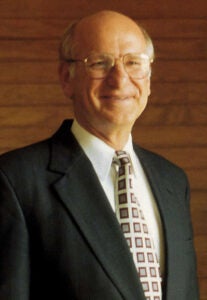
Jeffery Baker
Eighth President of Luther College (1996-1999)
Early Years and Life Before Luther
Jeffrey D. Baker, the eighth president of Luther College, was born November 23, 1941 in Sacramento, California. As a young boy, he learned the value of hard work and sacrifice from his father, a wholesale grocery salesman, and of honesty and integrity from his mother.
At the age of 18, Baker left home to attend the U.S. Air Force Academy, where he learned about building leadership skills. In 1964, Baker married Shirley Watson in Colorado Springs, CO, and earned a B.S. in international affairs from the U.S. Air Force Academy. He then went on to become a Air Force pilot instructor from 1964-1970. Baker then left Colorado and received his M.B.A. in management and labor relations from Arizona State University in 1971.
In 1976 Baker returned to the Air Force Academy in Colorado Springs to become an assistant professor, and during the next four years he also became a deputy for research and for economics. He then left the Academy again and attended the Foreign Student Service in Washington D.C. from 1980-1981.
From 1981-1983, Baker served as air attaché for the American Embassy in Rangoon, Burma. During these years he was also an assistant dean for graduate programs and continuing education at Defense Intelligence College in Washington D.C.
In 1984 Baker became an associate professor of economics and business at Carrol College in Helena, MT, a position he held for three years before becoming an associate director and associate professor at Patterson School of Diplomacy and International Commerce at the University of Kentucky. In 1988 Baker returned to Carrol College to become the vice president for academic affairs and dean of the college, a position he held until 1993. In that year Baker became the Commissioner of higher education of the Montana University System from 1993-1996.
Years at Luther
Jeffrey Baker was inaugurated as the eighth president of Luther College on Saturday, November 23rd, 1996. His wife, Shirley, accompanied him to Decorah. Their children Christine, Craig, and Christopher regularly visited to participate in Luther College events.
While at Luther, Jeffrey Baker moved the Office of the President to a more central location, altered the organization of the administration, and attempted to expand Luther’s endowment in order to finance his campaign to create new buildings on campus. One of Baker’s main goals was to transition Luther College into the 21st century without forgetting or losing the value of the college’s history and traditions.
After serving as President of Luther College for two years, Jeffrey Baker was diagnosed with lung cancer in 1998 and resigned from his position on March 19, 1999. He moved to California, where he passed away on March 22, 1999.
Other Information
Baker Village, the group of Scandanavian-style townhouses located across College Drive from campus, was named in honor of Jeffrey Baker in 1999. The Baker family continue to take an active interest in Luther College, including his wife Shirley, children Christine, Craig, and Christopher (Amber), and grandson Cade.
Resources in the Luther College Archives
- Engelhart, Carole, “Jeffrey Baker: building a consensus,” Luther Alumni Magazine Vol. 29, No. 4
- Who’s Who in the Luther College Archives
External Resources
Search the Archives
Contact Information
Hayley Jackson
College Archivist Librarian
John Werner
Processing Archivist
Preus Library 310
Upper Floor
Luther College
700 College Drive
The Archives is open for research from 1:00-4:30, Monday-Friday, and by appointment.
archives@luther.eduPhone: 563-387-1805